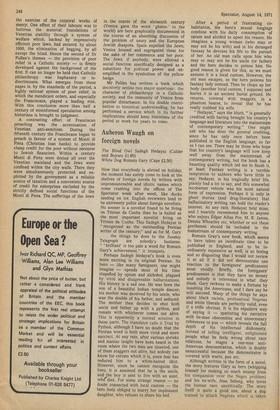Dermot Fenlon on the stability of Venice
Rich and Poor in Renaissance Venice Brian Pullan (Blackwell £6.50) By the close of the sixteenth century the freedom of Venice from popular disturbance was becoming a subject of envy and admiration throughout Europe. Observers like Bodin and Botero pointed to the skill of the aristocracy in admitting the people to controlled substitutes for political power, and in creating a state debt to give them a vested interest in the regime. Their comments provide a point of departure for Mr Brian Pullan's monumental study of the way in which the Venetian rich treated the Venetian poor. His first theme (there are two) is the contribution of philanthropy to power : the maintenance of the latter through the regulation of the former, or, as one commentator expressed it, the introduction of the plebs to " publike authoritie . . . without having occasion to hate or perturbe the estate of nobilitie."
Put that way it sounds plausibly Macchiavellian. Dr Pullan's findings, however, confirm the suspicion that Machiavellism is rarely a sufficient guide to conduct, even in societies which happened to revere their aristocracy. He gives due attention to government regulation of organisations catering for the relief of poverty which were never allowed to " perturbe the estate of nobilitie " by emerging as rival centres of patronage or command. They came into existence independently of government initiative, and for purposes which take us beyond the irerspectives of Bodin and Botero. What really happened was that charitable corporations developed in response to social and religious imperatives, and were then harnessed by government to secure the ends of state.
The organisations in question, as they first developed, were confraternities of the moderately comfortable — civil servants, lawyers, textile workers, corn merchants, cheesemakers, vintners and innkeepers. They were known as the Scuole Grandi. They met for devotional purposes, and in time developed into charitable societies, transferring wealth from the richer of their members to the ' respectable ' poor among themselves — the distressed nobility, artisans and small shopkeepers — below which social levels they rarely penetrated. They did not as a rule, before the sixteenth century, attend to the needs of the sick, the abjectly poor, the social outcasts. These tasks were taken over by the mixed societies of priests and laymen which, developing in the period of the Catholic revival, were imported from Rome and then adapted in Venetian territories (and elsewhere) to meet the demands created by plague, famine and inflation. Under the aegis of the civil and ecclesiastical authorities the new religious institutes built hospitals and other foundations for the relief of the sick, for prisoners, debtors and their families, for the reform of prostitutes and for the upbringing and education of orphans. Their object was the salvation of souls through the exercise of the corporal works of mercy. One effect of their labours was to buttress the material foundations of Venetian stability through a system of welfare which, backed by impressively efficient poor laws, had secured, by about 1600, the elimination of begging, by all except the blind. Hence the second of Dr Pullan's themes — the provision of poor relief in a Catholic society — is firmly developed against the background of the first. It can no longer be held that Catholic philanthropy was haphazard or indiscriminate. What emerges from these pages is, by the standards of the period, a highly rational system of poor relief, in which the mendicant orders, and especially the Franciscans, played a leading role. With this conclusion more than half a century of misinformed speculation among historians is brought to judgment.
A contrasting effect of Franciscan preaching was the accentuation of Venetian anti-semitism. During the fifteenth century the Franciscans began to preach in favour of a system of Monti di Pieta (Christian loan banks) to provide cheap credit for the poor without recourse to Jewish financiers. Within a century Monti di Pieta were dotted all over the Venetian mainland and the Jews were confined within the city walls. There they were simultaneously protected and exploited by the government as a reliable source of taxation and a convenient source of credit for enterprises excluded by the strictly defined social functions of the Monti di Pieta. The sufferings of the Jews in the course of the sixteenth century (Venice gave the word 'ghetto' to the world) are here graphically documented in the course of an absorbing discussion of the problem of usury and the European Jewish diaspora. Spain expelled the Jews; Venice housed and segregated them for the sake of her commerce and her poor. The Jews, if anybody, were allotted a social function specifically designed as a substitute for political power and exemplified in the symbolism of the yellow badge.
Mr Pullan has written a book which decisively settles two major questions : the character of philanthropy in a Catholic society, and the immunity of Venice from popular disturbance. In his double contribution to historical understanding, he has performed a service which in its further implications should keep historians of the period at work for years to come.



































 Previous page
Previous page